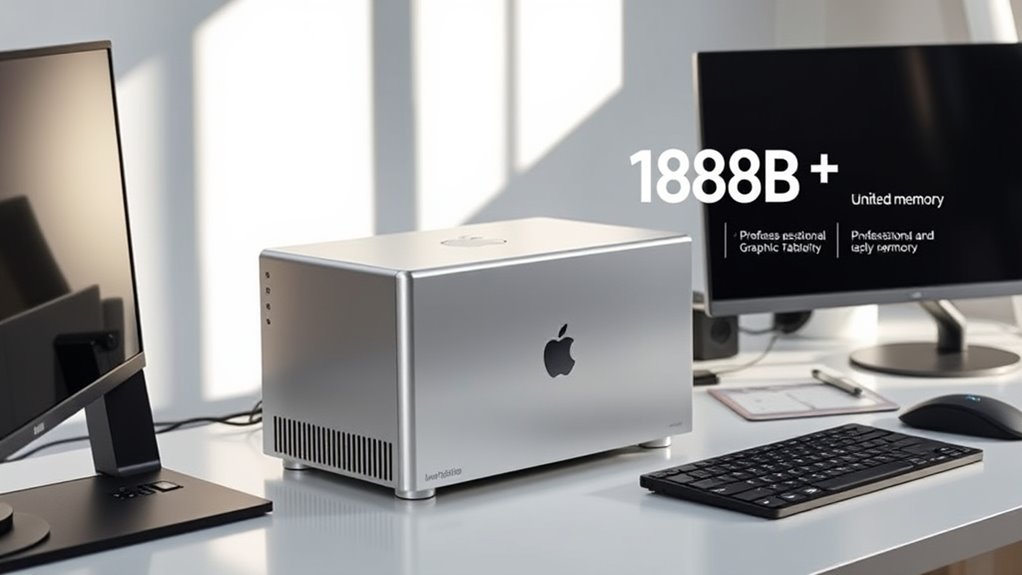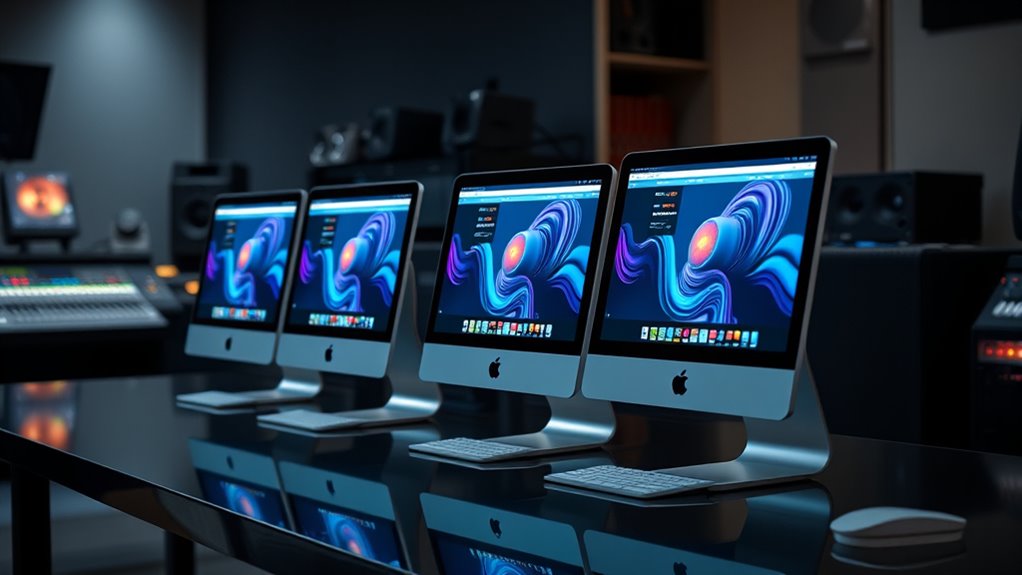If you’re a power user seeking the best Mac Studio models with 128GB+ unified memory, I recommend considering the M1 Ultra, M2 Ultra, and M2 Max configurations. These models offer top-tier performance for tasks like 3D rendering, AI, and large dataset processing. They support multiple 8K displays and come with robust connectivity options. Keep exploring to find out which setup fits your needs perfectly and how to maximize your workspace.
Key Takeaways
- Mac Studio models with M1 Ultra, M2 Ultra, and M2 Max chips support 128GB+ unified memory, ideal for intensive workflows.
- These configurations offer up to 8TB SSD storage for large datasets and professional project files.
- Equipped with Thunderbolt 5, HDMI, and USB-C ports, they support multiple high-resolution external displays (up to 8K).
- High RAM capacity enhances multitasking, reduces processing times, and future-proofs demanding professional tasks.
- Suitable for power users involved in 3D rendering, AI, large data processing, and complex creative workflows.
Apple Mac mini Desktop Computer with M4 Chip (2024)
If you’re looking for a compact desktop that combines powerful performance with seamless ecosystem integration, the Apple Mac mini with M4 chip (2024) is an excellent choice. Its small five-by-five-inch size makes it perfect for any workspace, fitting easily next to your monitor. Powered by the M4 chip with a 10-core CPU and GPU, it delivers fast, responsive performance for demanding tasks. With 24GB of unified memory and a 512GB SSD, multitasking and storage are smooth. Multiple ports, including Thunderbolt, HDMI, and Gigabit Ethernet, ensure easy connectivity. Plus, it’s designed to work flawlessly within the Apple ecosystem, enhancing productivity and device synergy.
Best For: users seeking a compact, high-performance desktop with seamless Apple ecosystem integration for work, creative tasks, and everyday use.
Pros:
- Compact design fits easily into any workspace or home setup
- Powerful M4 chip with 10-core CPU and GPU delivers fast, responsive performance
- Versatile connectivity options including Thunderbolt, HDMI, and Gigabit Ethernet
Cons:
- Limited internal storage options may require external solutions for extensive data needs
- No built-in display or dedicated graphics card for high-end gaming or professional graphics work
- Slightly higher price point compared to traditional mini PCs with similar specs
Apple 2024 Mac mini Desktop Computer with M4 Chip
The Apple 2024 Mac mini with M4 chip stands out as an excellent choice for creative professionals and power users who need a compact yet high-performing desktop. Its sleek aluminum design measures just 5×5 inches and weighs only 1.5 pounds, making it highly space-efficient. Despite its small size, it offers robust connectivity, including Thunderbolt 4, HDMI, Ethernet, and front USB-C ports. Powered by the M4 chip, it delivers a 10-core CPU, 10-core GPU, and up to 32GB of unified memory, enabling smooth multitasking and demanding workflows like video editing and AI tasks. Its impressive performance packs a punch in a tiny footprint.
Best For: creative professionals and power users seeking a compact, high-performance desktop capable of handling demanding workflows like video editing, 3D rendering, and AI tasks.
Pros:
- Compact and sleek aluminum design ideal for space-constrained environments
- Powerful M4 chip with a 10-core CPU, 10-core GPU, and up to 32GB of unified memory for smooth multitasking
- Supports up to three external displays, enhancing productivity and creative flexibility
Cons:
- Lack of USB-A ports necessitates adapters for certain peripherals
- Power button placement on the bottom may be less intuitive for some users
- Base memory options may be limiting for extremely demanding tasks
Apple Mac mini Desktop Computer with M4 Chip (256GB SSD, 16GB RAM)
For users seeking a compact yet powerful desktop, the Apple Mac mini with M4 chip offers an ideal solution. Its small footprint measures just 5×5 inches, making it easy to place next to your monitor or anywhere in your workspace. Powered by the M4 chip with a 10-core CPU and GPU, along with 16GB of unified memory, it handles demanding tasks effortlessly. The 256GB SSD provides fast storage, while multiple ports—including Thunderbolt, HDMI, USB-C, and Ethernet—ensure versatile connectivity. Despite its size, this Mac mini delivers impressive performance, seamlessly integrates with Apple devices, and supports essential apps for power users.
Best For: users seeking a compact, high-performance desktop that seamlessly integrates with the Apple ecosystem and handles demanding tasks efficiently.
Pros:
- Small footprint suitable for any workspace, measuring just 5×5 inches.
- Powerful M4 chip with 10-core CPU and GPU for fast, fluid performance.
- Versatile connectivity options including Thunderbolt, HDMI, USB-C, and Ethernet.
Cons:
- Limited storage capacity with 256GB SSD may require external drives for extensive files.
- May be overpowered for basic tasks, making it less cost-effective for casual users.
- No upgrade options for RAM or storage after purchase.
Apple 2024 Mac mini Desktop Computer with M4 Pro Chip
The Apple 2024 Mac mini with M4 Pro chip stands out as a compact yet highly powerful desktop option, especially suited for creative professionals and demanding users. Despite its small 5-inch footprint and lightweight design, it packs impressive performance with a 12-core CPU, 16-core GPU, and a 35% boost in AI tasks thanks to the Neural Engine. It supports up to three high-resolution displays, including 8K, and offers flexible connectivity with Thunderbolt 5, HDMI, Ethernet, and front USB-C ports. With options for up to 64GB of unified memory and 8TB of SSD storage, it’s ideal for intensive workflows, all wrapped in a sleek aluminum chassis.
Best For: creative professionals and demanding users seeking a compact, high-performance desktop capable of handling intensive workloads and multi-display setups.
Pros:
- Compact size with a sleek aluminum design ideal for space-saving setups
- Powerful M4 Pro chip with significant CPU, GPU, and AI performance boosts
- Supports up to three high-resolution displays, including 8K, for multitasking and creative workflows
Cons:
- Lack of USB-A ports, requiring adapters for legacy peripherals
- Less intuitive placement of the power button at the bottom of the device
- Base models with limited memory may restrict very demanding tasks or future-proofing
Factors to Consider When Choosing Mac Studio With 128GB+ Unified Memory

When choosing a Mac Studio with 128GB+ of unified memory, I consider my specific memory needs and how much processor power I require for my tasks. I also look at display options, connectivity, and how well the system fits my budget for the best value. These factors help me pick the right model to match my workflow and setup.
Memory Capacity Needs
Are you wondering how much memory you really need in a Mac Studio? If you’re tackling large datasets, complex 3D rendering, or heavy multitasking, 128GB or more can make a noticeable difference. Such high memory capacity helps cut down processing times for demanding apps like video editing, simulation, or machine learning. It also guarantees your system can handle multiple high-performance programs simultaneously without slowing down or crashing. Plus, opting for more RAM future-proofs your setup, keeping it compatible with evolving software and larger project files. Fundamentally, choosing a higher memory configuration allows for smoother, more efficient performance in memory-intensive tasks. If you want a machine that keeps up with your professional workload and minimizes bottlenecks, investing in ample RAM is a smart move.
Processor Performance Levels
Choosing the right processor performance level is crucial when selecting a Mac Studio with 128GB+ unified memory because it directly affects how well your system handles demanding tasks. The processor options include the M1 Ultra, M2 Ultra, and M2 Max chips, each with varying core counts and processing power. Higher performance levels, such as 24-core or 38-core configurations, greatly boost multi-threaded performance, critical for intensive workloads like rendering or AI tasks. The M2 Ultra and M2 Max chips also offer better energy efficiency and thermal management, enabling sustained high performance during prolonged use. Selecting a higher processor performance level ensures faster data processing, smoother multitasking, and better future-proofing for demanding applications, making it essential for power users who need maximum processing capability.
Display Compatibility Options
Considering the high-performance capabilities of Mac Studio models with 128GB or more of unified memory, it’s vital to pay attention to display compatibility options. These Macs support multiple high-resolution external displays simultaneously—often three or more—depending on the configuration. Compatibility with 6K, 8K, or 4K displays is handled via Thunderbolt 4 or HDMI, offering flexibility for professional workflows. When selecting monitors, keep in mind that higher resolutions like 6K or 8K may require specific ports or adapters, such as Thunderbolt or DisplayPort, for maximum performance. The graphics capabilities of the M4 Pro or M4 Ultra chips ensure smooth handling of multiple or high-resolution screens, making these setups ideal for demanding creative tasks. Proper compatibility guarantees seamless multi-monitor experiences without lag.
Connectivity and Expansion
When selecting a Mac Studio with 128GB+ of unified memory, it’s essential to guarantee it offers enough ports and expansion options to meet your workflow demands. I look for models with ample Thunderbolt, USB-C, and HDMI ports to connect peripherals and external displays seamlessly. Supporting high-resolution displays, like 6K or 8K, is fundamental for maximizing workspace and productivity. Fast wired connections, such as 10Gb Ethernet, are critical for transferring large files efficiently. I also check for multiple PCIe expansion slots or Thunderbolt ports that enable future upgrades or specialized peripherals. Additionally, flexible storage options like expandable SSDs help accommodate growing data needs. Ensuring these connectivity features are available guarantees my setup remains adaptable, efficient, and capable of handling demanding professional workflows.
Budget and Value
Investing in a Mac Studio with 128GB or more of unified memory can be a significant expense, so it’s crucial to weigh whether the performance benefits align with your budget. High-memory configurations usually come with a premium price, so consider if the increased memory will genuinely improve your workflow and productivity. For long-term use, this investment can be cost-effective by reducing the need for future upgrades or additional hardware. When evaluating value, compare the upfront cost with potential time savings and efficiency gains, especially if you run demanding applications regularly. Striking a balance between your budget and necessary memory ensures you get the best performance without overspending on features you may not need.
Frequently Asked Questions
How Does 128gb+ Unified Memory Impact Software Performance?
I find that having 128GB+ of unified memory considerably boosts software performance, especially for demanding tasks like video editing, 3D rendering, and large-scale data processing. It allows my applications to run smoothly without frequent lag or slowdowns, even when multitasking. This much memory ensures my workflow remains efficient, minimizes crashes, and handles complex projects with ease, making it ideal for power users who need top-tier performance.
Are There Any Compatibility Issues With High-Memory Mac Studio Models?
Think of high-memory Mac Studios as a well-oiled machine; they’re built for compatibility, not chaos. I haven’t encountered any issues connecting peripherals or running software, as Apple designs these to work seamlessly within their ecosystem. Rest assured, these models are optimized for power users, and I find them incredibly reliable. The only thing to watch for is ensuring your software is updated for the latest hardware.
What Are the Typical Use Cases for 128gb+ Memory Configurations?
When I opt for 128GB or more of unified memory, it’s usually for heavy-duty tasks like 3D rendering, video editing, large-scale data analysis, or software development with multiple virtual machines. I find that this much memory helps me run demanding applications smoothly without slowdowns. It’s especially useful when I work with complex projects that require a lot of multitasking or handling large files, ensuring seamless performance.
How Does Memory Size Influence Upgrade Options and Future-Proofing?
Increasing memory size directly impacts upgrade options and future-proofing by providing more headroom for demanding tasks and software updates. I find that with 128GB or more, I can run multiple intensive applications simultaneously without slowdowns, ensuring my setup stays relevant longer. Larger memory also reduces the need for future upgrades, saving me time and money. It’s a smart investment if I want my device to remain powerful and adaptable over the years.
Is There a Significant Difference in Energy Consumption With Higher Memory?
Higher memory in Mac Studio models does lead to slightly increased energy consumption, but the difference isn’t huge. I’ve found that more RAM helps with multitasking and intensive tasks, so I prefer models with ample memory despite the minor energy increase. For power users like me, the performance benefits outweigh the small impact on power usage, especially since these Macs are designed to be efficient even with higher specs.
Conclusion
Choosing the right Mac Studio model with 128GB+ unified memory is like selecting the perfect brush for a masterpiece. Each option offers its own palette of power and potential, tailored to your creative journey. Remember, your choice shapes the canvas of your work—bold strokes or fine details. Trust your instincts and pick the one that resonates with your vision. After all, this is your most vibrant creation yet.











